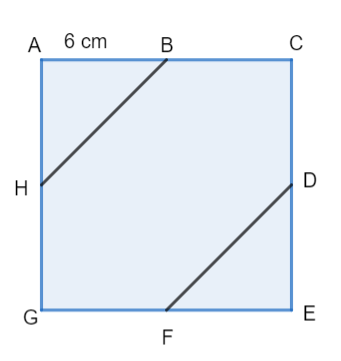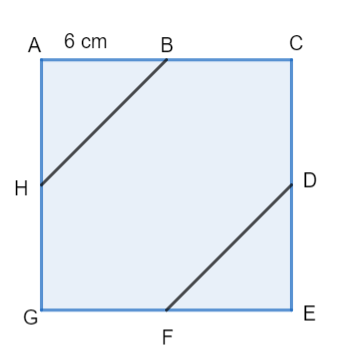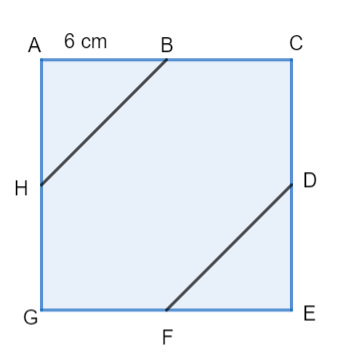
ACEG is a square. AB is


Answer
510.6k+ views
Hint: From the question, it was given that B is the midpoint of side AC and the length of side AB is equal to 6 cm. Now we have to find the length of BC. We know that the sum of length of AB and length of BC is equal to AC. In the similar way, we should find the length of GA, CE and EG. We know that the perimeter of a figure is equal to the sum of all sides of a figure. So, the perimeter of square ACEG is equal to sum of sides AC, CE, EG and GA. This will give us the perimeter of square ACEG.
Complete step-by-step answer:
From the square ACEG, it is clear that B is the midpoint of side AC. The length of side AB is equal to 6 cm. It is also clear that B is midpoint of AC, D is midpoint of side CE and F is the midpoint of side GE. It was also given that the length of side AB is equal to 6 cm.

As B is the midpoint of AC, the length of BC is also equal to 6 cm. From the figure, it is clear that the sum of length of AB and length of BC is equal to AC.
As D is the mid-point of CE, the length of CE is also equal to 6 cm. From the figure, it is clear that the sum of length of CD and length of DE is equal to CE.
As F is the mid-point of GE, the length of GE is also equal to 6 cm. From the figure, it is clear that the sum of length of GF and length of EF is equal to GE.
As H is the mid-point of AG, the length of AH is also equal to 6 cm. From the figure, it is clear that the sum of length of AH and length of HG is equal to AG.
We know that the sum of all sides is equal to perimeter. Let us assume the perimeter of square ACEG is equal to p.
So, the perimeter of ABCD is equal to 48 cm.
Hence, option A is correct.
Note: This problem can be solved in an alternative way.
From the square ABCD, it is clear that B is the midpoint of side AC. The length of side AB is equal to 6 cm. It is also clear that B is midpoint of AC, D is midpoint of side CE and F is the midpoint of side EG. It was also given that the length of side AB is equal to 6 cm.

As B is the midpoint of AC, the length of BC is also equal to 6 cm. From the figure, it is clear that the sum of length of AB and length of BC is equal to AC.
We know that the lengths of all sides are equal.
We know that the sum of all sides is equal to perimeter. Let us assume the perimeter of square ACFG is equal to p.
So, the perimeter of ACEG is equal to 48 cm.
Complete step-by-step answer:
From the square ACEG, it is clear that B is the midpoint of side AC. The length of side AB is equal to 6 cm. It is also clear that B is midpoint of AC, D is midpoint of side CE and F is the midpoint of side GE. It was also given that the length of side AB is equal to 6 cm.

As B is the midpoint of AC, the length of BC is also equal to 6 cm. From the figure, it is clear that the sum of length of AB and length of BC is equal to AC.
As D is the mid-point of CE, the length of CE is also equal to 6 cm. From the figure, it is clear that the sum of length of CD and length of DE is equal to CE.
As F is the mid-point of GE, the length of GE is also equal to 6 cm. From the figure, it is clear that the sum of length of GF and length of EF is equal to GE.
As H is the mid-point of AG, the length of AH is also equal to 6 cm. From the figure, it is clear that the sum of length of AH and length of HG is equal to AG.
We know that the sum of all sides is equal to perimeter. Let us assume the perimeter of square ACEG is equal to p.
So, the perimeter of ABCD is equal to 48 cm.
Hence, option A is correct.
Note: This problem can be solved in an alternative way.
From the square ABCD, it is clear that B is the midpoint of side AC. The length of side AB is equal to 6 cm. It is also clear that B is midpoint of AC, D is midpoint of side CE and F is the midpoint of side EG. It was also given that the length of side AB is equal to 6 cm.

As B is the midpoint of AC, the length of BC is also equal to 6 cm. From the figure, it is clear that the sum of length of AB and length of BC is equal to AC.
We know that the lengths of all sides are equal.
We know that the sum of all sides is equal to perimeter. Let us assume the perimeter of square ACFG is equal to p.
So, the perimeter of ACEG is equal to 48 cm.
Recently Updated Pages
Master Class 11 Economics: Engaging Questions & Answers for Success

Master Class 11 Business Studies: Engaging Questions & Answers for Success

Master Class 11 Accountancy: Engaging Questions & Answers for Success

Questions & Answers - Ask your doubts

Master Class 11 Accountancy: Engaging Questions & Answers for Success

Master Class 11 Science: Engaging Questions & Answers for Success

Trending doubts
A boat goes 24 km upstream and 28 km downstream in class 10 maths CBSE

Why is there a time difference of about 5 hours between class 10 social science CBSE

The Equation xxx + 2 is Satisfied when x is Equal to Class 10 Maths

What is the full form of POSCO class 10 social science CBSE

Change the following sentences into negative and interrogative class 10 english CBSE

How do you prove that the diagonals of a rectangle class 10 maths CBSE




